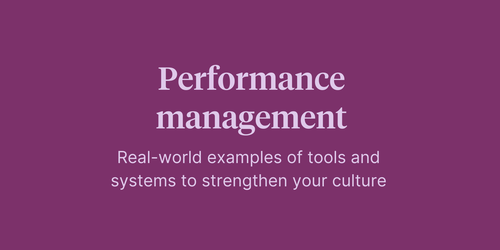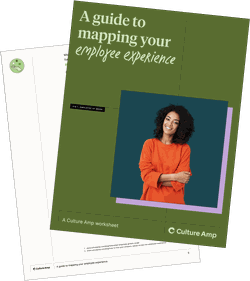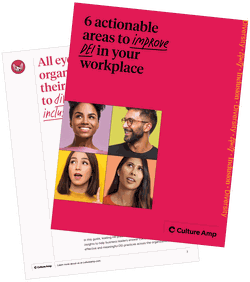
Article

Written by

Senior Content Marketing Manager, Culture Amp
It’s been over half a year since the phenomenon known as “The Great Resignation” swept the world of work, and the momentum doesn’t seem to be slowing down.
According to the US Job Openings and Labor Turnover Survey report, 4.3 million people left their jobs in August, with the “quits rate” – which measures voluntary separation initiated by the employee – at a series high of 2.9%. BankRate’s August 2021 Job Seeker Survey reported that some 55% of people are likely to look for a new job in the next 12 months. Unfortunately for many organizations, these numbers indicate that turnover, retention, and recruitment will likely remain key priority (and/or problem) areas.
With so many employees either having already left or making plans to take the leap in the near future, HR teams are increasingly hard-pressed to find and fill the talent gap left by departing employees. For many DEI practitioners, there’s a fear that the rush to hire candidates will reverse some of the careful and hard-won progress made in the diversity, equity, and inclusion space.
Aubrey Blanche, Culture Amp’s Senior Director of Equitable Design, Product & People, explains:
“A year after companies have made commitments to DEI – and to racial justice specifically – many companies have only made a little progress. What we’re now seeing is that those bits of progress are being chipped away at by a variety of factors: increased competition for underrepresented talent, the need for additional caregiving at home, as well as burnout and other mental health consequences that many are suffering from because of the impact of overlapping crises in our communities.”
In this article, we examine why it’s not just important, but beneficial, for organizations to maintain a steady focus and commitment to DEI during the Great Resignation. We’ll also share four DEI efforts that will make a meaningful difference during this period of high turnover.
In what ways could the Great Resignation pose a risk to your DEI efforts?
A major area is hiring and representation. Today, organizations are struggling to “win” in an extremely competitive talent market. With businesses struggling to operate with fewer hands on deck, HR teams are in a time crunch to fill empty positions. As a result, the desire to simply fill a role with any qualified candidate has often overtaken previous commitments to increasing the representation of candidates from historically marginalized backgrounds.
In the article “The Great Resignation Doesn’t Have to Threaten Your DE&I Efforts,” Arthur Woods explains:
“Many talent teams that were already facing capacity issues are now struggling to fill gaps with qualified and available candidates, much less ones from diverse communities. In a climate where underrepresented job seekers are in high demand and many will be part of the cadre leaving their jobs in the next year, organizations face a major risk of seeing their diversity numbers get worse.”
Diversity numbers are obviously just one small (and slightly controversial) aspect of DEI, but losing representation can contribute to engagement, culture, and inclusion issues down the line. Stagnating DEI progress can also lead to major retention issues related to worsening employee experiences for people from underrepresented communities. Consider the following, hypothetical cycle:
What do we mean by “cultural issues” in #5? The first example to come to mind is how less-diverse, homogenous workplaces experience greater groupthink and a narrower range of perspectives. Fewer differences mean there are fewer opportunities for employees to broaden their worldview through contrasting ideas and perspectives. Plus, interacting with folks from unfamiliar walks of life is one of the most meaningful and powerful ways to uncover and unlearn unconscious biases.
For these reasons, the less diverse a team becomes, the more likely it is that microaggressions could occur and corrode company culture and sense of belonging. This is especially true if leadership is homogenous, and diversity only exists in the lower levels of the organization.
“Building representation and an inclusive culture are complex system-level problems, and when one part of the system gets disrupted, it can have cascading and magnifying effects on your culture. That’s why it’s critical to holistically invest in DEI, rather than focusing simply on recruiting. It’s just not enough to move the needle, especially in these times,” explains Aubrey.
Building representation and an inclusive culture are complex system-level problems, and when one part of the system gets disrupted, it can have cascading and magnifying effects on your culture. That’s why it’s critical to holistically invest in DEI, rather than focusing simply on recruiting. It’s just not enough to move the needle, especially in these times
Aubrey Blanche
Senior Director of Equitable Design, Culture Amp
Turnover just drives more turnover, especially if you put DEI efforts on hold, too. Social justice matters more than ever to current and potential employees – regardless of background – and your people may feel disillusioned and misled if diversity numbers and efforts slide backward. This is particularly true if your organization made a bold promise to put DEI first in the wake of Black Lives Matter, Stop AAPI Hate, or other social justice movements. Yes, hiring is challenging and turnover is costly, but continuously losing DEI progress may very well drive more employees out of the organization, and customers out of the funnel.
From a business standpoint, keeping a sharp focus on DEI – especially during the Great Resignation – just makes sense. Diverse, equitable, and inclusive workplaces have been proven to experience a significant competitive advantage. Here are just a few benefits of diversity, equity, and inclusion in the workplace:
Building a diverse, equitable, and inclusive world of work has never been easy, but it’s worth the effort to keep DEI at the forefront during the Great Resignation. It’s the right thing to do, both as a leader and as a human being.
Organizations have to think beyond simplistic diversity numbers during the Great Resignation. In other words, you need to think beyond hiring and toward how DEI affects the greater employee experience.
DEI is good for everybody, but taking on DEI during the Great Resignation requires a genuine approach. By genuine, we mean that companies take real and meaningful actions on DEI, even during times of uncertainty when hiring is tenuous and pressure is high. Remember: even if you successfully hire qualified folks from diverse communities, they won’t stay for long if the employee experience isn’t equitable. There’s a reason only 3% of Black employees want to return to the office full-time compared to 21% of White employees.
Your DEI efforts can make a difference during the Great Resignation, but only if your organization is ready to take on the hard work of undoing and rebuilding the organizational systems that perpetuate inequity and exclusion in the workplace. So, is your company willing to take real steps to assess and achieve pay and promotion equity? Are your leaders ready to have difficult conversations by listening to employees from underrepresented backgrounds about, for instance, lack of accessibility or experiences with workplace discrimination?

We know meaningful change takes time and dedication. To help you get started, we’ve outlined seven initiatives that can make an impact – both directly and indirectly – during the Great Resignation.
By collecting information on the employee experience and DEI, you can gather the data and insights you need to take high-impact actions that improve retention, turnover, and inclusion. Here are some ways you can gather key information:
This feedback is especially valuable for winning leadership buy-in. Armed with data-driven insights across the employee journey, you can implement meaningful changes to close disparities, engage and retain current talent, and attract potential candidates during the Great Resignation and beyond.
Takeaway: If you aren’t doing so already, start collecting feedback on the employee experience. However, it’s crucial to take action on the feedback, or your employees will stop giving it. Didier Elzinga, Culture Amp’s CEO, explains, “The most typical reason people don’t want to fill out your survey is because you haven’t done anything since the last one. They don’t have survey fatigue; they have lack-of-action fatigue.”
What does “diversity” mean at your organization? Many organizations still prioritize gender parity over all else. However, focusing on women first doesn’t solve the problem of diversity, nor does it address the way intersectionality can compound and magnify certain advantages and disadvantages.
Organizational leaders must reflect on what “diversity” means to them, and how this definition carries through to hiring, promotion practices, and more. For example, how many people at your organization are part of the disability community? If this number is low, then is there something about your hiring practices that exclude people with disabilities from joining your organization? Are you giving formerly incarcerated job seekers a fair chance?
Like it or not, we’re all subject to unconscious biases. Sometimes, these biases can trick us into thinking that a candidate is unqualified simply because they’re from a certain community. Other times, these biases may lead us to altogether overlook groups of people that don’t look or live “like us.”
Takeaway: Be intentional about the kind of representation that you’re seeking, based on the gaps you have in your organization. If you haven’t already, start building relationships that can help you diversify your hiring pipeline. That way, even when hiring needs are high, your organization will be able to access a more diverse pool of candidates, rather than default to the “usual” candidates.
Here are a few suggestions to get you started on relationship building:
The past 18 months have made it clear that people can’t simply toss their “life” and all its complexities aside from 9 to 5. People have struggled with everything from the sudden shift to a remote/hybrid model, to fears for job security and stresses of caretaking. Unsurprisingly, organizations that have been unwilling to accommodate and support the range of human experiences are likely experiencing the most turnover.
In the report “The Great Work/Life Divide,” Catalyst found that “roughly two in five employees are considering leaving their job because their company (41%) or their manager (37%) has not cared about their concerns during the pandemic.”
In designing programs and systems to support employees’ humanity at work, organizations must consider the inequities that exist across the organization, society, and even virtual work environments. For example, an ABC News/Ipsos poll revealed that Black and Latinx Americans were three times as likely to know someone who has died from coronavirus. Another report found, “Women have been disproportionately affected by job loss and the caregiving burdens arising from school and care provider closures, with consequences for their career opportunities, economic security, and mental health.”
Takeaway: Part of reducing disparities and establishing equity is offering flexibility and benefits that accommodate the range of human experiences – not just the experiences that you’re familiar with. Managers and leaders should strive to empathize and understand people’s unique life circumstances, instead of assuming that generic wellbeing programs will benefit every employee equally.
In analyzing the survey responses of over 300,000 employees who voluntarily exited during the 15 months prior to the pandemic, our People Scientists found that 1 in 3 employees selected lack of growth (in career or development opportunities) as a top reason for leaving at the time of exit. After re-running this analysis in August 2021 with a new cohort of over 100,000 employees who exited between January to August 2021, our People Scientists found the same results still held true.
These findings should come as no surprise – people who don’t see an opportunity for growth at a company will inevitably seek opportunities outside of that company. However, folks from underrepresented groups generally face more barriers to growth, development, and promotion.
For instance, research by Lean In found that for every 100 men promoted to manager, only 58 Black women are promoted, despite the fact that Black women ask for promotions at the same rate as men. These women also experience greater everyday discrimination and are less likely to get the support and access they need to advance.
The reason for these unequal opportunities? Likely, a vast array of deep-rooted biases, such as affinity bias, which is the tendency for people to associate with people like themselves, or name bias, which arises when someone’s name does not conform with your comfort zone.
Great Resignation or not, growth and development matter for engagement and retention. But even if your organization does provide opportunities for growth and development, you may still find yourself losing high-performers from underrepresented communities because you’re not providing equal opportunities for advancement.
Takeaway: Diversity in leadership matters, so create opportunities that set underrepresented groups up for success and advancement (ie. training, mentor programs, skip-level meetings). Then, actually promote them.
With nearly 80% of workers saying they want to work for a company that values diversity, equity, and inclusion, it’s hard to believe that DEI isn’t a key strategy in winning the ongoing talent race. Creating a diverse, equitable, and inclusive workplace raises the bar for every employee – current and potential – so don’t put your DEI efforts on hold during the Great Resignation.
